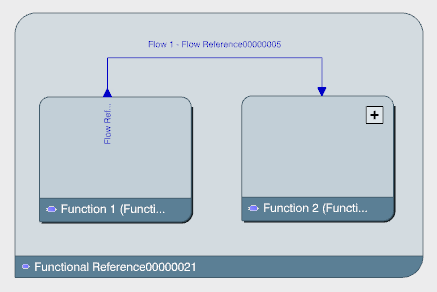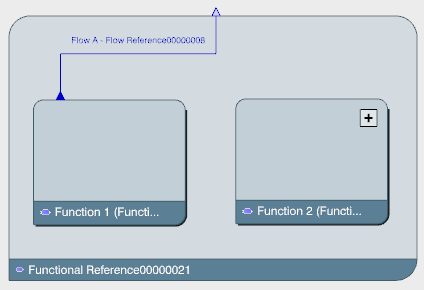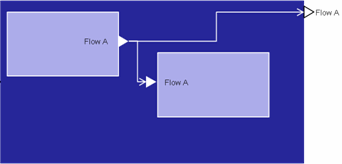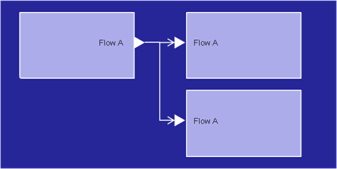About Functional Connections | ||
| ||
Functional Connections
When creating a new functional connection, you define:
- A flow
- The function emitting that flow
- The function consuming it.
You also create a link in the 2D view between these functions to visualize the exchange.
A functional connection is an explicit representation of the flow exchange between two functions. This exchange is defined as soon as the flow associations are defined on the functions (even if the functional connection is not created).
Using Create Functional Connection ![]() , you can create a new functional connection. The connection can be made between functions that have the
flow emission/consumption specified (using the
Associate Existing Flow option) or with new flow (
Associate New Flow option).
, you can create a new functional connection. The connection can be made between functions that have the
flow emission/consumption specified (using the
Associate Existing Flow option) or with new flow (
Associate New Flow option).
With the Create Functional Connection ![]() , you can create a functional connection:
, you can create a functional connection:
- Between the functions from the same level (sibling case)
- Where the
connection links a flow emission to a consumption of the same
flow.

- Between a function and one of its subfunctions (parent-child case)
- Where the connection links two emissions or two consumptions of the
same flow.

- Between two functions from different branches or levels
In such cases, the command creates as many connections as necessary.

- If one function is in the substructure/a child of the other,
then the Create Functional Connection
 command creates flow associations
and parent-child connections to connect all the levels between the
two selected functions.
command creates flow associations
and parent-child connections to connect all the levels between the
two selected functions.For example: Using the Create Functional Connection
 command between Function 1 and
Function 3 creates three flows on Function 1, 2 and 3 and two
connections between these three flows.
command between Function 1 and
Function 3 creates three flows on Function 1, 2 and 3 and two
connections between these three flows.
- If the two functions are in two different branches of the
Functional tree, the Create Functional Connection
 command connects the required
parent-child and sibling functional connections.
command connects the required
parent-child and sibling functional connections.
For example: To connect the two components Function 3 and Function 6, five flows and four connections are created.

- If the two functions are not in the same Functional tree, then
the Create Functional Connection
 command results in no action,
because the functions you are connecting have to be in the same
Functional tree.Note: When using the Create Functional Connection
command results in no action,
because the functions you are connecting have to be in the same
Functional tree.Note: When using the Create Functional Connection command to connect two functions
from different level, this method results in the reuse of an existing flow
association on the intermediate functions. This can lead to the
creation of concentration cases (two connections pointing to the
same input flow association).
command to connect two functions
from different level, this method results in the reuse of an existing flow
association on the intermediate functions. This can lead to the
creation of concentration cases (two connections pointing to the
same input flow association).
- If one function is in the substructure/a child of the other,
then the Create Functional Connection
| Tip:
If not already done so, set up your environment using .
If the default environment does not include a function
customization in authoring mode, the Create New Functional Connection |
You can connect automatically flow associations (functional ports) that are still not connected, provided that they have identical flows and compatible directions. See Autoconnecting Interfaces or Ports
For a manual connection, see Creating Functional Connection.
You can also connect automatically subfunctions together and generate the interface of the parent function (flows emitted and consumed by the function). See Creating Connection with Functional Connection Wizard.
Functional Connections with Wizard
The Functional Connection Wizard works on a function selected before or after executing the command. It works in two ways:
- Connect existing flow association together: Connection between subfunctions (or MUX/DEMUX) or between the function and the subfunctions (or MUX/DEMUX) manipulating the same flow (with compatible direction) are created automatically - if not already existing.
- Update Parent function signature based on
unconnected children flow associations. For each subfunction with unconnected flow
associations:
- A flow association (same direction, linked to the same flow) is automatically created on the parent function – if not already existing.
- A connection is automatically created between the subfunction (or MUX/DEMUX) and the parent function flow associations.
| Warning:
If the customization of the flow association and connections to be created includes mandatory attributes, it is necessary to define a knowledge script that valuates these attributes. If there is no script, or if the script doesn't valuate all the mandatory attributes, the Functional Connection Wizard command results in error. |
- If a flow is associated to the function and subfunctions
- A
connection is created between the subfunctions and the function
flow associations:
-
Before the Functional Connection Wizard
 .
.
-
After the Functional Connection Wizard
 .
.
-
- If several subfunctions are consuming a flow emitted by another subfunction
- They are all automatically
connected by the wizard:
-
Before the Functional Connection Wizard
 .
.
-
After the Functional Connection Wizard
 .
.
-
- If several subfunctions are consuming a flow not emitted by another subfunction
- They are all automatically connected by the
wizard to a single flow consumption at the parent level:
-
Before using Functional Connection Wizard
 .
.
-
After using Functional Connection Wizard
 .
.
-
- If all the subfunctions ports are already connected together or with the function port
- The Functional Connection Wizard
 command does not create anything:
command does not create anything: - If functions are connected with MUX/DEMUX
- MUX/DEMUX objects are managed like a subfunction. The input and
output ports are connected to the other subfunctions or to the
parent function:
-
Before using Functional Connection Wizard
 .
.
-
After using Functional Connection Wizard
 .
.
-